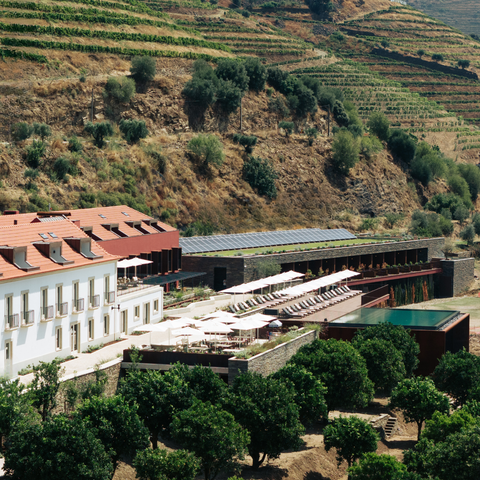
September 11, 2025 | TRAVEL
a RETREAT AMONG the VINES: TOREL QUINTA DA VACARIA
words Onur Basturk
photos Luis Ferraz (Courtesy of Quinta da Vacaria)
I knew I had truly arrived in the Douro Valley—the northern Portuguese wine region stretching from Porto to the Spanish border—when terraced vineyards began to blanket every hillside in sight. The view from the car was nothing short of spectacular: vines climbing from steep slopes all the way to the hilltops, while the Douro River wound peacefully through the valley floor. And then, just an hour and a half later (the drive from Porto Francisco Sá Carneiro Airport), the hotel where I would spend the weekend appeared quietly before me: Torel Quinta da Vacaria.
A HISTORY ROOTED IN THE 1600s
The Douro Valley is the world’s oldest demarcated wine region, with viticulture here dating back to Roman times. The vineyards that include the estate I stayed at—Quinta da Vacaria—date back to 1616. That year, when the property became part of the Society of Jesus, its story began to be recorded. It started to take shape with a house built by Friar Luís Álvares de Távora. Even then, the estate was producing around 70 barrels of wine annually—an impressive figure for the era. The chapel dedicated to Our Lady of the Good Event, built in 1732, still stands almost entirely intact today at the entrance of the hotel.
Over the following 150 years, Quinta da Vacaria grew significantly. What began as 25 hectares has expanded to 60 hectares of vineyards, with a vital role in producing world-class Port and DOC wines. In 2015, the estate was acquired by the Portuguese Marec Group, and shortly after, in collaboration with the Torel Boutiques group, the hotel project began. Torel Quinta da Vacaria is therefore a newcomer—having opened only last year.
SCHISTÓ: A GASTRONOMIC HIGHLIGHT
If anything matches the meditative walks through the vineyards and the serene river views from my room, it is the gastronomy. The hotel’s standout dining destination—one not to be missed even if you’re not staying overnight—is Schistó. Named after the region’s emblematic schist stone, the restaurant is a “tribute to Portuguese cuisine” shaped by the vision of Portugal’s most Michelin-starred chef, Vítor Matos (holder of five stars), together with chef Vítor Gomes and sous-chef Carolina Columbano.
With only 14 seats, Schistó offers an intimate experience where guests sit directly before the open kitchen. The space feels like a fine dining theatre, with floor-to-ceiling pale green drapes and Guatemalan green marble underfoot creating an atmosphere that disconnects you from the outside world.
Among the dishes I sampled—part of what is described as a “ten-moment gastronomic journey”—my favourites were the Rainbow Trout from the Douro River and a reinterpreted version of the traditional Cozido à Portuguesa. As Chef Matos explains: “We took Douro’s traditional, familiar Portuguese cuisine and turned it into a fun and daring experience. At the heart of our kitchen are always the ingredients—we try to extract as much flavour as possible.”
And a special thanks must go to sommelier Carlos Eduardo. Thanks to his pairings, I discovered wines so exceptional that, ever since, I can hardly bring myself to accept anything less.

A MUST: WINE TASTING AT CASA DA VINHA
Another unforgettable moment during my stay was the experience at Casa da Vinha, perched atop the vineyards with sweeping 360-degree views across the Douro. If possible, walk there rather than take a buggy—the climb through century-old vines takes no more than 20 minutes. At the top, you’re rewarded with an extraordinary wine-tasting session. Reservations are essential, but the chance to explore Quinta da Vacaria’s finest wines in such a setting, guided by expert knowledge, was truly remarkable.
THE ASTOLFI TOUCH
The interiors of the hotel were entrusted to a familiar name: Joana Astolfi, founder of Studio Astolfi. Not long ago, I stayed at The Verse, one of Lisbon’s newest hotels, also designed by her, and I was captivated by her palette, material harmony, and refined details. At Torel Quinta da Vacaria, she continues this signature approach, sourcing ceramics, wicker, and wooden furniture primarily from Portuguese makers and artisans such as Depozito, A Vida Portuguesa, Oficina Marques, Banema Studio, Burel Chiado Interiors, Felipa Almeida, Bordallo Pinheiro, and Fabricaal.
Architect Luís Miguel Oliveira, meanwhile, preserved the white façade of the original main house while painting the estate’s second-oldest building burgundy to evoke wine—a detail that looks particularly striking from the pool, especially at sunset.
Many of the rooms also feature small outdoor bathtubs—mine included. If the weather had been warmer, I would have indulged without hesitation.
FINAL DETAILS
- Don’t be surprised if you feel a gentle tremor while sitting in your room—there’s a train line running just behind the hotel, and every so often one passes by. In fact, within the estate itself stands a historic railway bridge.
- At the hotel’s spa, be sure to book the Vineyard Experience. This 120-minute ritual begins with a body scrub made of salt, grape, wine, and almond oil, followed by a dip in a pool infused with Quinta da Vacaria’s grape- and red wine-based ingredients.

































